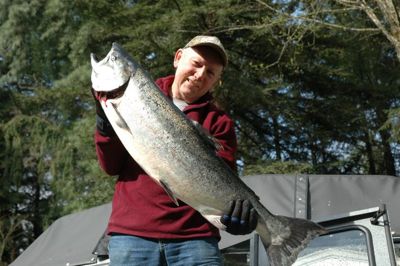forum
library
tutorial
contact

Big Spring Chinook Run Forecast for Columbia River
by Allen ThomasThe Columbian, December 12, 2011
|
the film forum library tutorial contact |

|
Big Spring Chinook Run Forecast for Columbia Riverby Allen ThomasThe Columbian, December 12, 2011 |
 A very strong run of 314,200 spring chinook -- the Northwest's premier salmon -- is forecast to enter the Columbia River in 2012 headed for upstream of Bonneville Dam.
A very strong run of 314,200 spring chinook -- the Northwest's premier salmon -- is forecast to enter the Columbia River in 2012 headed for upstream of Bonneville Dam.
"If it comes in at that number, that's pretty good," said Larry Swanson of Vancouver, a member of the bi-state Columbia River Recreational Fishery Advisory Group. "I'm pretty happy to see that. It could be a good spring chinook fishery."
The 2012 forecast calls for 36,400 5-year-old chinook, which which are larger and tend to return a bit earlier, and 277,400 4-year-olds. Four hundred 6-year-olds also are predicted.
The portion headed for the Columbia River upstream of Priest Rapids Dam is 32,600, while the Snake River prediction is 168,000.
State, federal and tribal biologists based the forecast of 4-year-olds -- the vast majority of the run -- on the count of jacks (3-year-olds) at Bonneville Dam, said Cindy LeFleur of the Washington Department of Fish and Wildlife, chair of the committee that prepared the forecast.
The method works relatively well when jack counts are large, she said. The jack count in 2011 at Bonneville was second best on record.
A year ago, the forecast was for 198,400 upper Columbia spring chinook, with the actual number entering the river being 221,200.
Other streams contributing to this run include Wind River, Drano Lake and Klickitat River, all on the Washington side of the Columbia River Gorge.
Swanson said he'd like to see the fishing season structured to provide as much opportunity as possible in the stretch between Interstate 205 and Cathlamet. He also suggested not having fishing from boats near Bonneville Dam so the bank fishermen are not impeded.
Harry Barber of Washougal, also a member of the bi-state advisory group, said he hopes the spring run is large enough to fish like in 2001, when the river was open daily for both boat and bank fishermen upstream to Bonneville Dam.
Boat fishing should be open at least upstream to Rooster Rock (near Corbett, Ore.) or possibly to Beacon Rock.
"It would be nice to give the people farther upstream some opportunity," he said.
Willamette River -- A forecast for Oregon's Willamette River is expected to be announced Tuesday. A year ago, the prediction was 104,100 and the actual return was 80,200. A forecast of about 80,000 is anticipated.
Cowlitz-Kalama- Lewis -- A total return of 12,100 fish is forecast to the three Southwest Washington tributaries where spring chinook return.
The forecasts break down to 8,700 for the Cowlitz, 700 for the Kalama and 2,700 for the Lewis River. In 2011, the returns were 4,100 to the Cowlitz, 800 to the Kalama and 1,400 to the Lewis.
Washington and Oregon fishery officials will share the upper Columbia and Willamette forecasts with various sport and commercial fishing groups in meetings this week.
Allocation of the harvest is a complicated balancing act involving non-Indians and the four Columbia River treaty tribes, plus splitting the non-Indian catch between sportsmen and commercial fishermen.
Details of the sport and commercial seasons will be adopted in late January or early February.
In 2011, sport fishing for spring chinook in the lower Columbia River closed initially beginning April 5, then was reopened from April 8 through April 20.
Summer chinook, sockeye -- The forecast for summer chinook, which return from mid-June through July to waters upstream of Priest Rapids Dam, is a very good 91,200. That compares with 80,600 a year ago.
The forecast for sockeye, which return mostly to the Okanogan River, is a huge 462,000. In 2010, a sockeye run of 187,300 returned.
Slightly more than 93 percent of the sockeye forecast is fish destined for the Okanogan, with most of the balance headed for the Wenatchee River and a handful to the Snake River system in Idaho.
Sockeye rarely bite on sport gear, but some are caught incidentally by anglers targeting on early summer steelhead in the lower Columbia.
learn more on topics covered in the film
see the video
read the script
learn the songs
discussion forum
